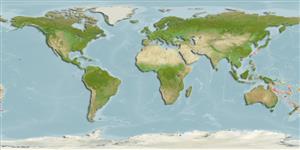Klassifizierung / Names
Namen | Synonyme | Catalog of Fishes(Gattung, Arten) | ITIS | CoL | WoRMS | Cloffa
>
Anguilliformes (Eels and morays) >
Congridae (Conger and garden eels) > Congrinae
Etymology: Gnathophis: Greek, gnathos = jaw + Greek, ophis = serpent (Ref. 45335); neocaledoniensis: Named for its type locality, near New Caledonia..
Environment: milieu / climate zone / depth range / distribution range
Ökologie
seewasser bathydemersal; tiefenbereich 520 - 580 m (Ref. 54804). Deep-water
Western Pacific: New Caledonia.
Size / Gewicht / Alter
Maturity: Lm ? range ? - ? cm
Max length : 18.5 cm TL Männchen/unbestimmt; (Ref. 54804)
Kurzbeschreibung
Morphologie | Morphometrie
Rückenflossenweichstrahlen (insgesamt): 219; Afterflossenweichstrahlen: 160; Wirbelzahl: 142 - 145. Diagnosis: Fins are light. The second pore of lateral line is elevated while the pores above the pectoral fin are not. Vertebrae 142-145; trunk vertebrae 45-47. Lateral line pores to vent 37-38. Supraorbital canal 6; suborbital canal 8; preoperculomandibular canal 10; occipital commissure 3. The stomach is light and peritoneum silvery (Ref. 54804).
Life cycle and mating behavior
Geschlechtsreife | Fortpflanzung | Ablaichen | Eier | Fecundity | Larven
Karmovskaya, E.S., 2004. Benthopelagic bathyal conger eels of families Congridae and Nettastomatidae from the Western Tropical Pacific, with descriptions of ten new species. J. Ichthyol. 44(1):S1-S32. (Ref. 54804)
IUCN Rote Liste Status (Ref. 130435)
Bedrohung für Menschen
Harmless
Nutzung durch Menschen
Mehr Information
NamenSynonymeMetabolismusRäuberÖkotoxikologieFortpflanzungGeschlechtsreifeAblaichenSpawning aggregationFecundityEierEientwicklung
Alter/GrößeWachstumLänge-GewichtLänge-LängeLängenhäufigkeitenMorphometrieMorphologieLarvenLarven Pop.Dyn.RekrutierungDichteBRUVS
ReferenzenAquakulturAquakultur ProfilZuchtlinienGenetikElectrophoresesVererbbarkeitKrankheitenVerarbeitungNutrientsMass conversion
PartnerBilderStamps, Coins Misc.LauteCiguateraGeschwindigkeitSchwimmstilKiemenoberflächeOtolithsGehirngrößeSehfähigkeit
Tools
Zusatzinformationen
Download XML
Internet Quellen
Estimates based on models
Preferred temperature (Ref.
123201): 6.7 - 9.8, mean 8.2 °C (based on 23 cells).
Phylogenetic diversity index (Ref.
82804): PD
50 = 0.5000 [Uniqueness, from 0.5 = low to 2.0 = high].
Bayesian length-weight: a=0.00062 (0.00028 - 0.00136), b=3.19 (3.00 - 3.38), in cm total length, based on LWR estimates for this (Sub)family-body shape (Ref.
93245).
Trophic level (Ref.
69278): 3.6 ±0.6 se; based on size and trophs of closest relatives
Widerstandsfähigkeit (Ref.
120179): hoch, Verdopplung der Population dauert weniger als 15 Monate. (Preliminary K or Fecundity.).
Fishing Vulnerability (Ref.
59153): Low vulnerability (10 of 100).
